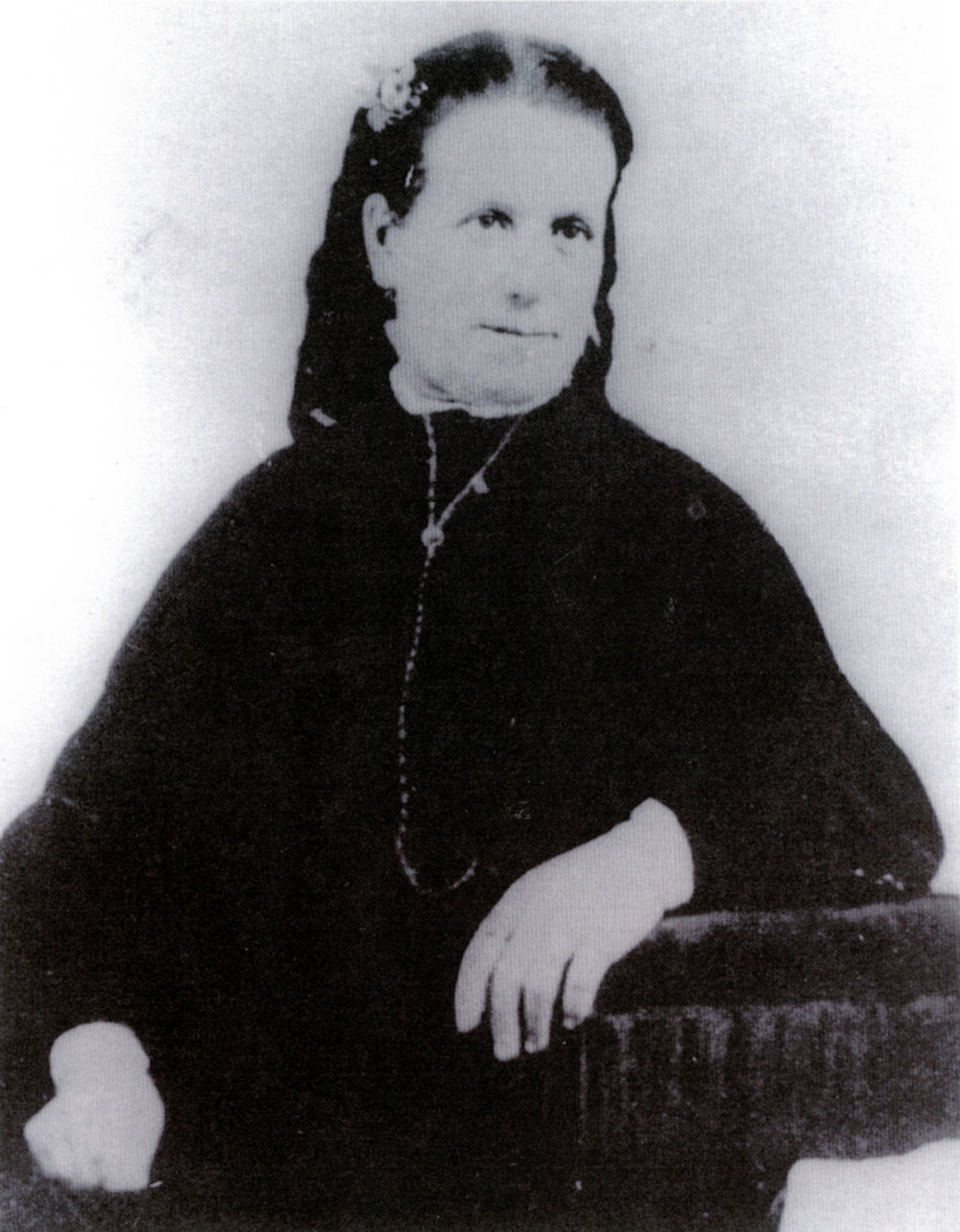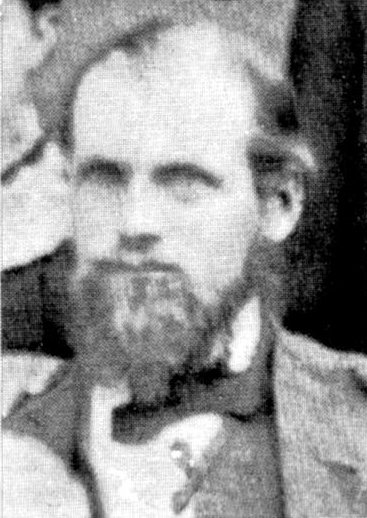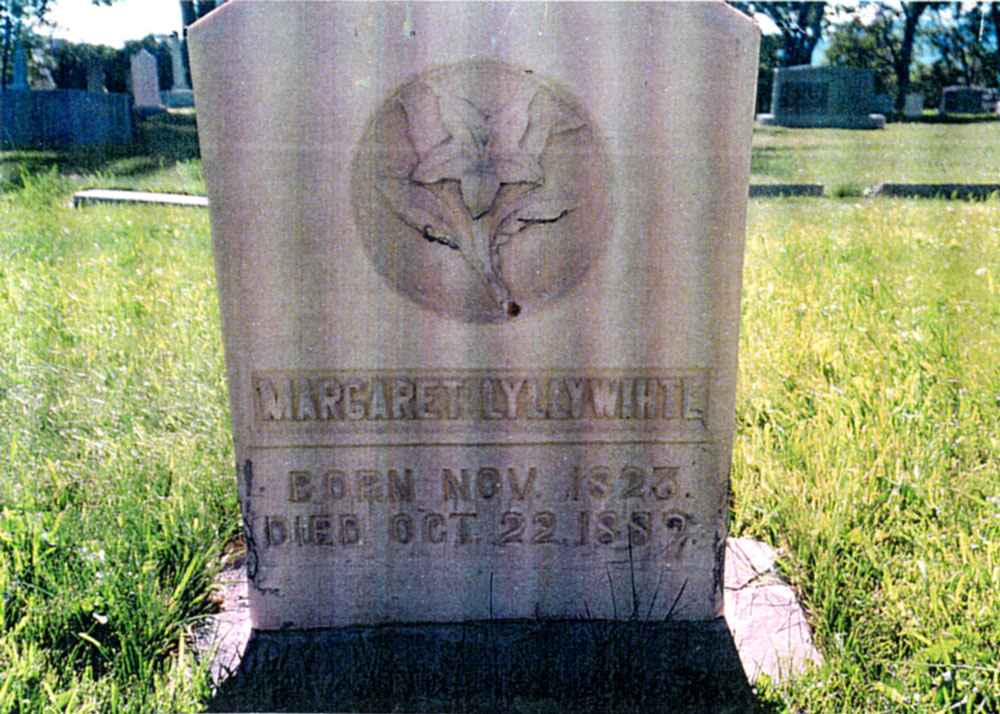Margaret Mitchell Lillywhite
Dorothy’s Great Great Grandmother
Margaret’s Life Sketch
by Eleanor Lillywhite Brown
Little is known of the early life of my great grandmother, Margaret Mitchell, who became the wife of Benjamin Lillywhite, the third of July 1843, in London, England. The marriage was performed in St. Gride’s Parish Church, according to the “Rites and Ceremonies” of the Established Church of England. Herbert Lascelles, Minister, performed the ceremony following the publications of Banns.
At the time of her marriage, Margaret gave her name as Margaret Masters, daughter of Benjamin Masters, who was in reality her step-father. Her own father was an officer in the British Army, and it is supposed that he was killed or had died. Margaret’s mother, Rebecca, married Benjamin Masters during Margaret’s childhood.
LDS Baptism
Just one year after her marriage, and several months before the birth of their first child, Margaret was baptized a member of the Church of Jesus Christ of Latter-day Saints, commonly known as the Mormon Church. Her husband, Benjamin, and several other members of the Lillywhite and Masters families also joined about the same time.
Margaret and Benjamin had a great desire to come to America and join the Saints in Zion. They commenced to work and save and plan to this end. Benjamin was a painter by trade.
Birth of Benjamin Lillywhite Jr.
On the 26th of September 1843, their first child, Benjamin, Jr. was born. Now their incentive to “gather to Zion” was greatly increased. They were anxious that their son should have the privilege of growing up in a Latter-day Saint community. To add to their anxiety a daughter, Sara, was born in 1845.
Emigration to Zion
By 1846, they were beginning to make definite plans for their emigration. About this time it was learned that two “Latter-day Saints,” missionaries from America who were in charge of the collection of funds and making all necessary arrangements to bring the saints to America in organized groups, had, through mismanagement and misappropriation of these funds, lost the money and incurred heavy debts for the Church. Because of this, President Brigham Young ordered all Church sponsored immigration halted until a thorough investigation could be made. The men were later excommunicated from the Church, but this did not lessen the heartache and hardship imposed upon those struggling Saints, many of whom lost their “stake.” Some fell away from the Church or had their testimonies weakened by the actions of these men, but others, like the Lillywhites, who were skilled in some trade or were in better financial circumstances were able to make their way unaided. And having made plans for the tremendously important move decided to come as independent family groups, assuming all responsibility for the voyage. For this reason we do not find the details of their passage from London to America in Church records, and we have no knowledge of the ship they came on or any of the details of their voyage.
Their names disappear from the records of the London branch after September 1846, and family tradition states they arrived in New York City sometime during the winter of 1846-47. After their arrival in New York, Benjamin Lillywhite obtained work and settled down to recoup their finances enough so they could continue their journey toward Zion. My grandfather, Joseph Lillywhite, was born in New York City the 15th of November 1847.
Sea Voyage
At that time the passage from England to America took from six to twelve weeks – depending on the weather and other factors. Their passage fare included “food rations” but each family had to prepare their own meals. The ships were not equipped with comfortable staterooms then as they are now. They were small sailing vessels – not luxury passenger liners. Picture, if you can, giving birth to a baby under these conditions, in the midst of the ocean. How strong the faith of those early pioneers and how much respect and admiration we, their descendants, owe them. But this was not the end of Margaret’s heart-breaking experiences – only the beginning.
Death of Benjamin Sr.
They remained in New York until Joseph was a year or so old, when they started on the next stretch of their trip to Zion. By this tine – late 1849 – the Saints had been forced to flee from their beautiful city of Nauvoo and had gone to Salt Lake. We do not know the exact time of the Lillywhite’s departure from the East or what route they followed to reach St. Louis, Missouri, which was at that time the outfitting post for the Utah bound companies of Saints. Our only records merely state that they went most of the way “by water,” and after they reached St. Louis, the husband, Benjamin, and the daughter, Sara, were stricken with the killer cholera and died. They were buried in that alien land in unmarked graves along with so many others, as there was a terrible plague of the cholera that year.
Now we find Margaret bowed down with grief, thousands of miles from her family and acquaintances, among bitter religious enemies, with no means of support, and with two small boys depending on her for care and protection. It was impossible for her to return to England to her people, or rather to her husband’s people, so she did the only thing she could do under the circumstances; she placed the two children in the care of Latter-day Saint families going out to Utah, while she remained in St. Louis to work until such time as she could finance her way to Utah. The oldest boy, Benjamin, then about six years of age, went with a family by the name of Miller. Joseph, just past two years old, was placed with another family – the name we do not know.
Several years later Margaret came out to Utah. By this time she had married again, as a plural wife, and according to the best evidence available, it was one of those cases sanctioned by the authorities – a marriage for convenience only – to permit a lone woman to travel over that pioneer trail without reproach. The marriage lasted only a short time, and was annulled.
Arriving in Zion
Upon reaching Utah she began the search for her boys. When she found the Millers, they persuaded her to leave Benjamin with them. They had become very much attached to him, and by this time he was old enough to help repay them for the years of care and protection they had given him. She had more difficulty finding the family who had Joseph, but when she did locate them, she took him without protest, and endeavored to make up for the years of separation. Both boys always held a very high regard for their mother and always tried to do all they could to make her life pleasant.
As soon as Joseph was old enough he went to work to help support himself and his mother, working at anything he could find to do, including several trips as teamster between Salt Lake City and the outfitting posts in Iowa and Missouri, for freight and to help other Saints in their move to Zion. These trips were under the direction of the Church authorities. When he was twenty years of age he was shot through the shoulder by the Indians — and left for dead — but that is another story, although one of the trying experiences in Margaret’s eventful life.
Life in Utah
During these years in Utah, Margaret Lillywhite married several times. So far as we know, in each case it was as a plural wife. As the wife of John Eldridge she had two children, a boy who died in childhood is buried at Beaver, Utah, and a daughter who later became the much loved “Aunt Maggie Williams” of Milford, Utah. For many years Aunt Maggie operated a boarding house in Milford which was the railroad terminus for towns in the general vicinity of Beaver. Some of my fond memories are of several nights and days spent there while en route to and from Beaver, to stay with Mother’s people, after we were forced to flee from our home in Mexico at the time of the Revolution there.
Plural Marriage
After the death of Mr. Eldridge, Margaret married a Mr. Elmer, by whom she had one son. This marriage apparently ended with pressure from the Government. Some of us may feel there were many trials attached to plural marriage, and even resent the fact that some of our people were participators in this part of our religious belief. Yet in many such instances, as was the case with this good woman, it was indeed a blessing. I am sure had it not been for this principle, and the good women among our people who were willing to have their husbands offer a measure of security and protection to other women less fortunate than themselves, Margaret’s problems and trials would have been much greater than they were.
Living in Beaver Utah
Margaret spent most of her life after coming to Utah in the vicinity of Cedar City, and her later years in Beaver, where both of her sons made their homes. The youngest son, Joseph, was called as a member of the noted “Hole-in-the-Rock” company to help settle the San Juan country. Later, after being released from this mission, he moved to Arizona, where he located with family at Woodruff.

Benjamin Lillywhite was bishop of the Greenville Ward, Beaver Stake in Utah from 1880 to 1885. He was ordained a bishop on April 11, 1880 by John R. Murdock.
Margaret was a very attractive and vivacious woman, who loved to wear nice clothes and have a good time. My mother’s sister, Aunt Sade Hutchings, who knew her very well, said she wore a flower or ribbon in her curly brown hair, and no matter how old or shabby her clothes, she always managed to wear them with a flair and a dash that made her appear well dressed. She was always cheerful and pleasant, never burdening others with any of her troubles.
Firm in the Faith
Margaret remained firm in her testimony of the Gospel, and it was a source of heartache to her that her daughter, Aunt Maggie, married out of the Church. Mr. Williams was a Christian Scientist and Aunt Maggie joined that group. But Grandmother Lillywhite always said she thought he was much more Mormon than Scientist.
Great-Grandmother Margaret made at least one trip out to Arizona to spend the winter with Joseph and his family. My father spoke frequently of her cheerful personality. He said my sister Elmina is much like her in personality and appearance.
Whenever I feel low in spirits, I only have to start reading or thinking of some of the sacrifices my forebears made in order that their posterity might enjoy the blessing of freedom and the light of the Gospel, and I realize anew just how very rich our heritage really is.
Submitted to the Spinning Wheel Camp, Daughters of Utah Pioneers by Eleanor Lillywhite Brown November 1960.



